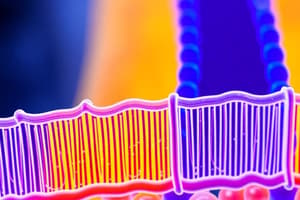Podcast
Questions and Answers
Which lipid is predominantly found on the inner leaflet of the plasma membrane?
Which lipid is predominantly found on the inner leaflet of the plasma membrane?
- Phosphatidylserine (PS)
- Sphingomyelin
- Phosphatidylcholine (PC)
- Phosphatidylethanolamine (PE) (correct)
What is the role of the enzyme scramblase during programmed cell death?
What is the role of the enzyme scramblase during programmed cell death?
- It exposes PS on the outer leaflet of the plasma membrane. (correct)
- It synthesizes cholesterol in the ER.
- It actively transports substances against their concentration gradient.
- It facilitates the diffusion of ions across the membrane.
Where does the majority of cholesterol synthesis occur?
Where does the majority of cholesterol synthesis occur?
- Endoplasmic Reticulum (ER) (correct)
- Mitochondria
- Plasma membrane
- Golgi apparatus
How does the distribution of cholesterol vary among different organelles?
How does the distribution of cholesterol vary among different organelles?
What is the primary function of membrane proteins?
What is the primary function of membrane proteins?
What is the primary role of the endoplasmic reticulum (ER) in the cell?
What is the primary role of the endoplasmic reticulum (ER) in the cell?
What is the main difference between the rough endoplasmic reticulum (RER) and the smooth endoplasmic reticulum (SER)?
What is the main difference between the rough endoplasmic reticulum (RER) and the smooth endoplasmic reticulum (SER)?
Which of the following post-translational modifications occurs within the endoplasmic reticulum (ER)?
Which of the following post-translational modifications occurs within the endoplasmic reticulum (ER)?
What is the primary role of the smooth endoplasmic reticulum (SER) in lipid metabolism?
What is the primary role of the smooth endoplasmic reticulum (SER) in lipid metabolism?
Which of the following is a crucial function of the endoplasmic reticulum (ER) in maintaining protein functionality?
Which of the following is a crucial function of the endoplasmic reticulum (ER) in maintaining protein functionality?
Where do the fatty acids used in the synthesis of complex lipids, such as cholesterol and steroids, originate?
Where do the fatty acids used in the synthesis of complex lipids, such as cholesterol and steroids, originate?
What is the primary function of the endoplasmic reticulum (ER) in regulating calcium homeostasis?
What is the primary function of the endoplasmic reticulum (ER) in regulating calcium homeostasis?
Why is the release of calcium ions from the ER into the cytoplasm essential?
Why is the release of calcium ions from the ER into the cytoplasm essential?
How does the ER interact with the plasma membrane to regulate cellular processes?
How does the ER interact with the plasma membrane to regulate cellular processes?
What is the role of the ER in its interaction with the Golgi apparatus?
What is the role of the ER in its interaction with the Golgi apparatus?
Which statement best describes the role of the ER in cell division?
Which statement best describes the role of the ER in cell division?
According to one theory, what is the evolutionary origin of the ER?
According to one theory, what is the evolutionary origin of the ER?
Flashcards are hidden until you start studying
Study Notes
Cell Membrane
Overview
The cell membrane, also referred to as the plasma membrane, is a critical component of every living cell. Surrounding the cell, the membrane serves as a selective barrier, regulating the passage of substances into and out of the cell. Composed primarily of fatty acid-based lipids and proteins, its unique structure allows it to maintain a balance between protecting the cell's contents and facilitating necessary exchanges with the external environment.
Structure
The cell membrane is approximately 75-100 Å thick and consists of two layers known as the lipid bilayer. This bilayer is composed primarily of phospholipids and sterols, particularly cholesterol. Phospholipids contain both hydrophobic fatty acid chains and hydrophilic polar head groups, making them amphiphilic molecules that can interact with both water and organic solvents. Cholesterol, on the other hand, is a sterol that helps maintain fluidity and stability within the lipid bilayer.
Proteins play another crucial role in the structure of the cell membrane. They can be extrinsic proteins, which are loosely attached to the surface through ion bonds or calcium bridges, and intrinsic proteins, which are directly embedded within the phospholipid bilayer. Membrane proteins participate in various functions such as transport, metabolism, and signaling within the cell.
Lipid Composition
The outer leaflet of the plasma membrane contains predominantly PC (phosphatidylcholine) and sphingomyelin, while PS (phosphatidylserine) and PE (phosphatidylethanolamine) are found on the inner leaflet. During programmed cell death, an enzyme called scramblase exposes PS on the outer leaflet, changing the charge of the plasma membrane and marking the apoptotic cell for phagocytosis by macrophages.
Cholesterol synthesis occurs in the ER (Endoplasmic Reticulum), but its distribution varies among different organelles. The ER has a relatively low cholesterol content, while its prevalence increases through the secretory pathway towards the Golgi apparatus and ultimately the plasma membrane. This increase in cholesterol contributes to slightly thicker membranes in late Golgi and plasma membranes and may aid in protein sorting through the pathway.
Protein Functions
Membrane proteins facilitate essential cellular processes. Some proteins serve as open channels, allowing ions to diffuse into the cell, while others act as facilitators, aiding in the diffusion of solutes past the lipid barrier. Additionally, there are pump proteins that actively transport substances against their concentration gradient when spontaneous diffusion is insufficient. Particles too large to pass through these mechanisms are often subject to endocytosis or exocytosis, whereby the cell membrane engulfs or expels material through fusion events.
Conclusion
Understanding the structure of the cell membrane is vital in comprehending its function in maintaining cellular integrity and enabling communication between cells and their environment. With its unique composition of lipids and proteins, the cell membrane serves as a dynamic and selective boundary, regulating access to and from the cell while also supporting key biological processes.
Studying That Suits You
Use AI to generate personalized quizzes and flashcards to suit your learning preferences.




